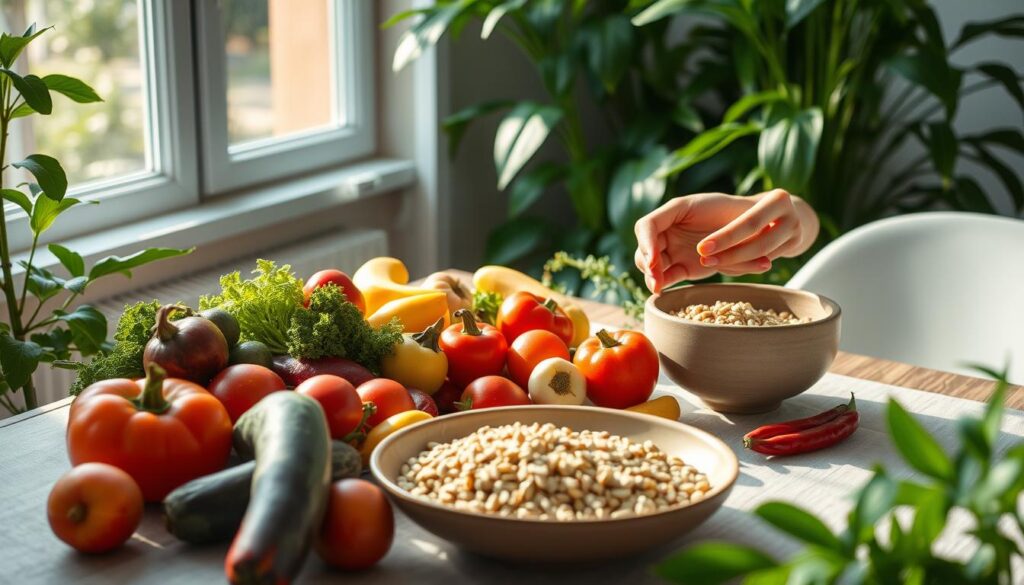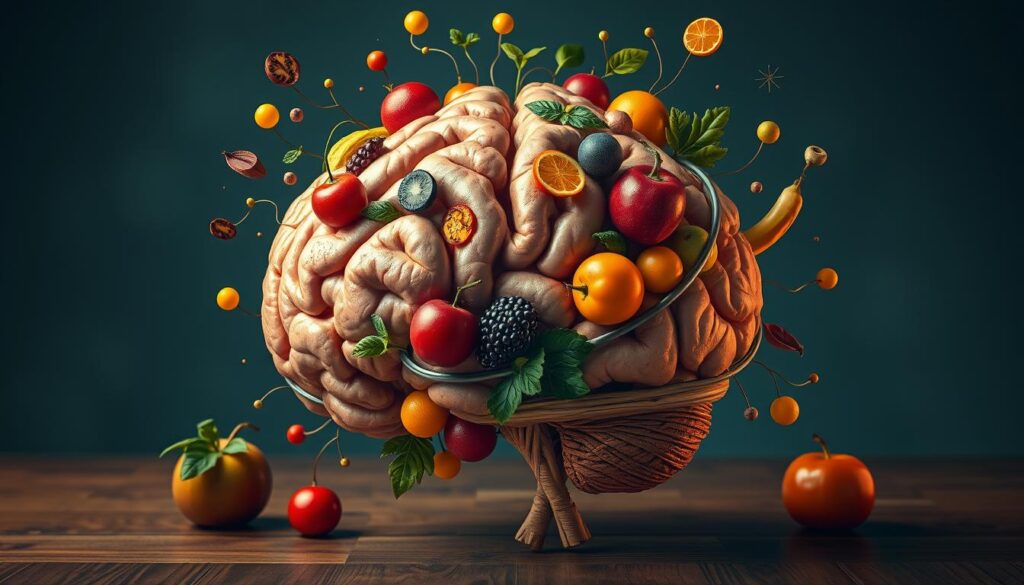Ever find yourself eating a whole bag of chips or a pint of ice cream without thinking? You’re not alone. Our fast-paced lives make it easy to forget about eating. But, there’s a way to change that. Welcome to mindful eating.
Mindful eating is more than just another diet. It’s a way to connect with food and enjoy every bite. By being present during meals, you learn what your body really needs. So, how does it work and what are the benefits? Let’s explore conscious eating together.
Key Takeaways
- Mindful eating is a transformative approach to food that can help you develop a healthier, more balanced relationship with eating.
- By learning to be present and attentive during mealtimes, you can better understand your body’s signals of hunger and fullness.
- Mindful eating can lead to increased enjoyment of food, better digestion, and a more positive mindset around eating.
- Incorporating mindful eating practices can help break the cycle of emotional and mindless eating.
- Transforming your kitchen and dining environment can support a sustainable mindful eating routine.
Ready to start your intuitive eating journey and improve your food relationship? Let’s begin!
Understanding Mindful Eating: A Path to Better Health
Mindful eating is more than a trend. It’s a way to change how we see food and our health. By being present during meals, we find many benefits that go beyond just eating.
The Science Behind Conscious Consumption
Science backs up mindful eating. Studies show we eat less and feel more satisfied when we focus on our food. This focus helps us know when we’re full.
Breaking Free from Autopilot Eating
Many of us eat without thinking, leading to overeating and poor digestion. Mindful present eating helps us make better choices. It stops us from eating without thinking.
Historical Origins of Mindful Eating Practices
The idea of mindfulness-based eating comes from ancient Eastern philosophies. These philosophies linked eating to spiritual and emotional health. By going back to these roots, we can enjoy a healthier, more joyful relationship with food.

“When we slow down and truly savor each bite, we not only nourish our bodies, but also cultivate a profound sense of gratitude and connection to the world around us.”
The Psychology of Your Eating Habits
Understanding the psychology behind our eating habits is key to a healthier relationship with food. The non-dieting approach and the anti-diet movement highlight how our thoughts and emotions influence our eating. This knowledge helps us nourish ourselves better.
Our eating habits are shaped by our subconscious, upbringing, and society. Recognizing these factors is the first step to changing unhealthy patterns. It leads to a more intuitive and self-compassionate way of eating.
Unraveling the Emotional Ties to Food
Many of us use food to cope with emotions or fill voids. This is called emotional eating. It can create a cycle of guilt and more eating. By being mindful, we can find healthier ways to deal with our emotions.
The Impact of Beliefs and Attitudes
Our beliefs about food and our bodies affect our eating. Negative self-talk and unrealistic beauty standards can lead to unhealthy eating. Changing these beliefs to a more positive, non-judgmental mindset is crucial for lasting change.
| Unhealthy Eating Patterns | Mindful Eating Approach |
|---|---|
| Emotional Eating | Addressing Emotional Triggers |
| Restrictive Dieting | Intuitive, Flexible Eating |
| Obsession with Calorie Counting | Focusing on Nourishment |
Understanding our eating habits’ psychology lets us adopt a more compassionate, non-dieting approach to food. This shift helps us avoid yo-yo dieting. It leads to a healthier, more sustainable relationship with food.

“Eating should be a joyful experience, not a source of guilt or shame. When we approach food with self-love and curiosity, we open ourselves up to a world of nourishment and self-discovery.”
Core Principles of Present-Moment Eating
Embracing mindful nutrition and attentive consumption changes how we view food. At the center are three key principles. They help us enjoy every meal and nourish our bodies and minds.
Engaging All Your Senses
Mindful eating starts with using all your senses. Look at the color, texture, and smell of your food before eating. As you chew, feel the flavors and the mouthfeel.
This awareness makes us appreciate our food more. It deepens our connection with what we eat.
Recognizing Hunger and Fullness Cues
- Listen to your body’s hunger and fullness signals. Check how full you are during meals, not just when the plate is empty.
- Notice physical signs like a growling stomach or feeling full. These help decide when to eat and stop.
- Don’t eat out of boredom or emotions. Know the difference between real hunger and cravings.
Creating a Mindful Eating Environment
The place where you eat affects your mindful eating. Turn off screens and avoid distractions. Eat with others or in quiet, focusing on your food.
This makes eating a calm, enjoyable experience. It helps us appreciate our food more.
| Principle | Description |
|---|---|
| Engaging All Your Senses | Dive into the sensory experience of your meal, from looks to tastes and textures. |
| Recognizing Hunger and Fullness Cues | Listen to your body’s signals to guide your eating and avoid eating without thinking. |
| Creating a Mindful Eating Environment | Reduce distractions and create a calm space for meals to support attentive consumption. |
By following these core principles, we can better appreciate our food. We find joy in every bite.
Breaking the Cycle of Emotional Eating
Many of us struggle with emotional eating. It’s when we use food to deal with our feelings, leading to a cycle that hurts our mindful eating and conscious eating goals. But, with the right steps, we can stop this cycle and improve our food relationship.
Recognizing why we eat emotionally is key. Do you eat when stressed, anxious, or bored? Think about what you really want – the food or the comfort it gives. This awareness helps us make better choices.
- Identify your emotional eating triggers. What situations or feelings make you overeat?
- Find new ways to cope, like walking, calling a friend, or relaxing.
- Look into why you eat emotionally, like past experiences, stress, or deeper issues.
Mindful eating is also a great tool. It involves enjoying each bite and listening to our hunger and fullness. This helps us stop eating out of emotion and builds a healthier food relationship.
The key to breaking the emotional eating cycle is to become more aware of your thoughts and feelings, and to find healthier ways to cope with them.
Improving our food relationship is a journey, not a quick fix. By using these strategies and being patient with ourselves, we can beat emotional eating. We’ll learn to nourish our bodies and minds in a more mindful and conscious way.
Practical Techniques for Mindful Eating
Ready to take your intuitive eating journey to the next level? Discover the power of practical techniques that can transform your relationship with food. They foster a more present, mindful approach to nourishing your body.
The Pause-and-Reflect Method
The pause-and-reflect method is a cornerstone of mindful eating. It’s simple yet effective. It encourages you to stop, take a deep breath, and check in with your body and mind before taking the next bite.
By pausing, you create space to become more aware of your hunger and fullness cues. You also become aware of the emotions or triggers that may influence your eating habits.
Mindful Portion Control Strategies
Mindful portion control can play a role in nurturing a healthy relationship with food. Try using smaller plates and savoring each bite slowly. Be mindful of the visual cues that signal when you’ve had enough.
This approach helps you develop a more intuitive understanding of your body’s needs. It does so without the rigid rules of traditional dieting.
Using Technology: Food Scan Genius App Guide
In our digitally-connected world, technology can be a valuable ally in your present eating journey. The Food Scan Genius app allows you to quickly scan product barcodes and access detailed nutritional information.
By bringing mindfulness to your grocery shopping and meal planning, you can make more informed, intuitive choices. These choices align with your health goals.
Remember, the key to successful mindful eating is to approach it with a sense of self-compassion and flexibility. Experiment with these practical techniques, and find the ones that resonate most with your unique needs and preferences. Your journey to a more intuitive, present-moment relationship with food starts here.
| Technique | Description | Benefits |
|---|---|---|
| Pause-and-Reflect Method | Stop, take a deep breath, and check in with your body and mind before taking the next bite. | Increases awareness of hunger and fullness cues, as well as emotional triggers. |
| Mindful Portion Control | Use smaller plates, savor each bite slowly, and pay attention to visual cues that signal when you’ve had enough. | Develops an intuitive understanding of your body’s needs without rigid rules. |
| Food Scan Genius App | Quickly scan product barcodes to access detailed nutritional information. | Supports more informed, intuitive choices during grocery shopping and meal planning. |
“The path to intuitive eating is paved with self-compassion and flexibility. Experiment, discover, and find what works best for you.”
Building a Sustainable Mindfulness-Based Eating Routine
Starting a mindful eating practice is a journey, not a quick fix. To keep these habits, we must build a routine that fits our lifestyle. Mindfulness-based eating is powerful because it nourishes us for life.
Begin with small steps. Set aside a few minutes each day for meals without distractions. As you get better, add more mindful moments to your eating.
- Find when you naturally eat mindfully. Use those times to grow your routine.
- Try different mindful techniques. See what works best for you.
- Get support from family and friends. They can help keep you on track.
- Celebrate your small victories. Mindfulness is a journey, and every step counts.
Creating a lasting mindfulness-based eating routine is not about being perfect. It’s about being kind to yourself and enjoying the journey. With time and effort, you can change how you see food and enjoy the benefits of healthy eating habits.
“The journey of a thousand miles begins with a single step.” – Lao Tzu
Transforming Your Kitchen into a Mindful Space
In our journey towards mindful nutrition and attentive consumption, our home environment is key. By changing our kitchens and dining areas, we can make a space that helps our mindful eating. This change supports and boosts our mindful eating habits.
Essential Tools for Mindful Meal Preparation
Starting with the right tools is crucial for mindful meal prep. Look into getting high-quality, versatile kitchen gadgets. A sharp knife, a solid cutting board, and measuring cups and spoons help you cook with care and focus.
Creating a Distraction-Free Dining Area
After cooking, having a quiet dining area is vital for mindful consumption. Choose a spot away from TVs, phones, and other digital distractions. Add calming touches like natural light, plants, or soft music. This creates a peaceful setting that helps you enjoy your food and the moment.
Organizing Your Pantry for Success
- Organize your pantry so you can see and easily reach what you need, helping you make mindful choices.
- Put similar items together, like grains, spices, and canned goods, to make cooking easier.
- Use clear containers or labeled jars to help you pick ingredients more thoughtfully.
| Essential Mindful Eating Tools | Benefits |
|---|---|
| High-quality chef’s knife | Precise, effortless cutting to enhance mindful preparation |
| Sturdy cutting board | Provides a stable surface for focused, attentive slicing and dicing |
| Measuring cups and spoons | Encourages mindful portion control and ingredient selection |
| Clear storage containers | Promotes visibility and conscious choice of pantry items |
By making your kitchen and dining area mindful spaces, you’ll be ready to follow mindful nutrition and attentive consumption in your cooking.
Integrating Food Scan Genius into Your Mindful Journey
The anti-diet movement has changed how we view food. It’s now about a deeper, healthier relationship with it. The Food Scan Genius app fits right into this mindset. It lets you scan barcodes to get info on what you eat.
This info includes nutritional facts, allergens, and more. It’s all at your fingertips. This way, you can make choices that are better for you.
Using the app helps you understand your food better. It lets you pick foods that fit your health goals. Whether you’re avoiding certain foods or looking for healthier options, the app is there to help.
The app also connects you with others who share your goals. You can find recipes, meal plans, and more. It’s a way to support each other on this journey.
Let’s make food a source of joy and discovery. Together, we can find a healthier, more mindful way to eat.
FAQ
What is mindful eating?
Mindful eating is about being fully present when you eat. It means using all your senses and listening to your body’s hunger and fullness signals. It helps you have a healthier relationship with food.
How does mindful eating differ from traditional dieting?
Mindful eating is not about following strict diets. It’s about listening to your body and eating in a way that feels right. It’s about being kind to yourself and enjoying your food without guilt.
What are the benefits of mindful eating?
Mindful eating can improve digestion and help with weight management. It reduces emotional eating and makes eating more enjoyable. It helps you appreciate the food you eat more.
How do I get started with mindful eating?
Start by paying attention to your senses while eating. Eat slowly and listen to your body’s hunger and fullness cues. Try to eat without distractions in a calm space.
Can mindful eating help with emotional eating?
Yes, it can. Mindful eating helps you understand your emotions and eating patterns. This way, you can handle emotional cravings in a healthier way.
How can technology support a mindful eating practice?
Apps like Food Scan Genius can help by giving you info on food. They let you track your eating habits. This makes choosing food more mindful.
What are some practical tips for incorporating mindful eating into my daily life?
Try pausing before you eat to check your hunger and emotions. Practice eating smaller portions and eat in a quiet place. This helps you stay focused on your food.
How do I make mindful eating a sustainable habit?
Start small, with one or two meals a day. Make it fun and find what works for you. Be patient and kind to yourself as you learn.





